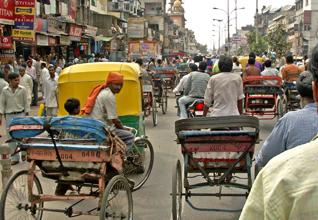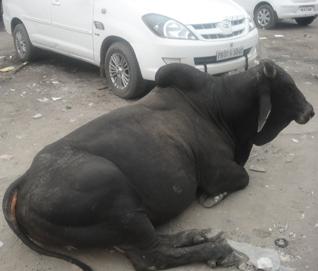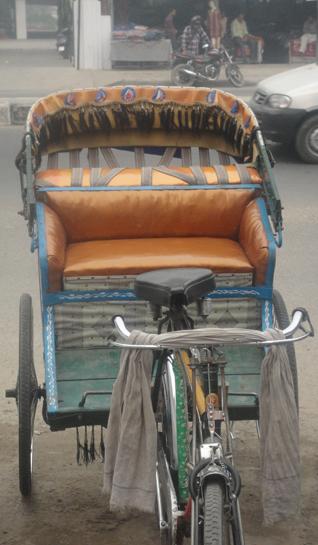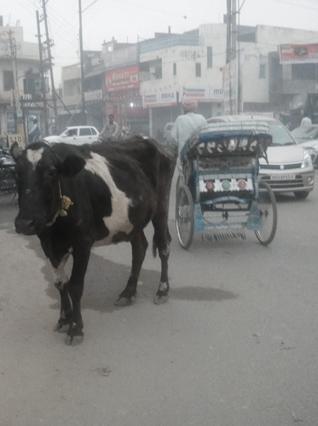Columnists
A BumperCar Symphony:
Traffic in India
by ROSALIA SCALIA
Recently, while preparing for a trip to India, almost without fail, my Indian friends forewarned me about the bad traffic there, describing how difficult it was to drive on narrow roads and how long it took to traverse from one point to another in the same city.
I envisioned gridlock. I envisioned bumper to bumper traffic, akin to the summer time traffic jams that piled up along all the routes leading to Ocean City, Maryland, U.S.A.
What I failed to imagine was that Indian traffic resembled nothing like American traffic. In the same way that wealth is relative, so is the idea of bad traffic. What my Indian friends had considered “bad traffic” turned out to be for me, a ginormous and fun-filled bumper car hall ride, complete with sound effects and an in-your-face immersion into nation’s vitality .
In India, as in the United Kingdom, the steering wheel of moving vehicles is located on the left side and traffic keeps to the left side of the road. But that is where the similarity between Indian and British traffic begins and ends.
In Indian cities, cars share the road with trucks decorated to resemble rolling birthday cakes, with rickshaws that include a dazzling array of decorated and undecorated bicycles jerry-rigged into passenger vehicles.
With autoshaws - three-wheeled, green and yellow motorized rickshaws with Piaggio imprinted on them.
With motorcycles, buses, bicycles, scooters often carrying more passengers than seems humanly possible outside the Cirque du Soleil.
Pedestrians, stray dogs, cows, bulls, camels, elephants, and everything and anything else that has legs.
None of the vehicles travel faster than 30 mph, and all the drivers employ the same chaotic rules of the road found in Sicily, except at a much slower speeds.
The words “Blow Horn” in large painted letters brandish backs of trucks, but the directive seems superfluous. From rickshaw drivers to truck drivers, Indian drivers liberally lean on their horns - as if it is a the directive to themselves - generating a veritable symphony, at times harmonic, at other times, dissonant, and frequently both.
Unlike at home where horns alert other drivers to an approaching hazard, horns in India constitute a musical instrument and a multi-purpose tool, announcing a vehicles’ presence, signaling changes in direction, serving as headlights, brakes, side and rear view mirrors. The slow speeds and the chaotic rules of the road often cause the diverse components comprising Indian traffic to regularly bump and bounce off each other.
Perched in either an autoshaw or a rickshaw, which are minus the glass barriers of larger vehicles, one can see and anticipate when a bump and bounce is about to occur. The rickshaws and autoshaws prove to be the most fun in which to ride. For someone plagued with motion sickness since infanthood, these vehicles offer a refreshing alternative. They don’t cause motion sickness like the cars/taxis, and the absence of glass windows translates into a steady stream of air flowing into my face and provides a unique proximity to the vibrancy - the colors, sounds, sights, and smells, including of animals - of all that’s around.
Regardless of which vehicle I happened to be traveling, the bump and bounce equals a barely-there collision that’s acknowledged and accepted with equanimity, without the exchange of insurance information, drivers’ names and contact info, or a single incident of road rage. No one emerges from his or her vehicles with flailing arms ready to engage in a shouting match over who’s at fault for the barely-there collision because everyone is intent on getting to wherever they’re going, oblivious of the richness of the horn symphony or effortless grace of the motion around them.
Conversation about this article
1: Kanwarjeet Singh (Franklin Park, New Jersey, U.S.A. ), December 14, 2011, 10:24 AM.
Dear Rosalia - the external reflection of a society is usually how the society internally fells. Lives in India for the most part are the same - disorganized, filled with noise and bumper-to-bumper collisions. I am not being critical of that way of life - it has its own charms. On the subject of traffic, did you ever guess why there are so many religions and petty gods and goddesses in India? (Hint: If you ever see people crossing the road or railtracks, you will know why). Here is an interesting article on sikhchic.com about flying in India - that is another adventure (more like a local bus service than an air-flight). http://sikhchic.com/article-detail.php?cat=20&id=2610
2: Sangat Singh (Kuala Lumpur, Malaysia), December 14, 2011, 10:59 AM.
Some 13 years ago, I decided to take a Punjab Roadways bus to travel from Patiala to Ludhiana. Naturally, the bus driver was a six-footer, burly Sardar. During that period, a Punjabi song - "Hai Jamalo", was the rage. I don't remember the lyrics, though. Within minutes of his taking his command seat, he inserted the cassette and turned it loud enough to be heard 20 miles away, and started to sing along to add extra mileage. Occasionally, he would let go of the steering wheel and move his hands in "wah wah". This was the time when the dual carriage-way was not yet constructed. It was a single, multipurpose road with no line to divide the road, and thus allowed the traffic to weave in and out impartially. It even allowed the shepherd herding goats to have the right of way. Of course, the burly bus driver's disdain was all too visible and as an added effect he would blare his horn to add to the accompanying invectives. Every now and then, we would pass a village that contributed scooters, auto-rickshaws, pigs, pedal rickshaws and bicycles to the traffic and allowed them unfettered access to the road as well. Despite these minor irritants, overtaking was mandatory. Every moving vehicle must overtake the one in front of it, but especially the one who has just overtaken you, and then you must occupy the middle of the road to give a fair chance to up and down traffic to hit you. After all, Singh is King! On this occasion, the two truck drivers rattling along towards each other from the opposite direction recognized each other, flashed their headlights, and braked to a grinding halt beside each other, wholly blocking the road. They exchanged shrill greetings with each other, reaching out to shake hands and then reluctantly went on their way, completely oblivious of the cacophony of horns from both sides of the divide, with practiced indifference. Where can you get such camaraderie? If you want to see and feel India, take a Punjab Roadways bus, but with an assumption of immortality. If you survive, it was your own fault. On another occasion, my nephew picked me up from the airport and drove like mad. When I commented that he was a bad driver, his response was: "No, Mama ji, I am a better driver than most ... the bad ones are all dead!"
3: Balraj Kaur (New Delhi, India), December 14, 2011, 11:31 AM.
It was another Italian - Dante - who described India and its traffic perfectly in equally poetic words: "Through me you pass into the city of woe:/ Through me you pass into eternal pain:/ Through me among the people lost for aye/ ... All hope abandon ye who enter here."
4: Lucky (Maryland, U.S.A.), December 14, 2011, 7:50 PM.
Wow. I remember my time in India - 2 years in the late 90's. I could not believe how the traffic was - my sisters and I would play a game in the car where we would take turns, starting with the letter "A" - where we would have to name something found on Indian roads. By the time we got to "D" it was obvious this was the easiest game EVER-R-R because ANYTHING could be found on Indian roads! Indian roads are so treacherous in some places that the Discovery channel showcased them in a series on the world deadliest byways. Crazy - especially up in the mountains! Usually it's all fun but once my friend was in a 3-wheeler auto rickshaw, and it went over a bump and a nail in the roof of the rickshaw went into her head. Could have been a scenario for an installment of the 'final destination' movies. Indian traffic is a beast - and yeah, I was amazed too at how people just kinda rolled with it. They say if you don't believe in God - go to India :)) Great article - loved reading your take on the cacophony, er ... I meant symphony.
5: Baldev Singh (Bradford, United Kingdom), December 14, 2011, 11:00 PM.
The best highways are being built in the middle of nowhere! The drive a few hours from Calcutta is so soothing and a joy to see so many Sikh truckers resting at laybyes. The problem is too many people wanting the 'American Dream' and not enough space to live it!
6: Rosalia Scalia (Baltimore, Maryland, U.S.A.), December 15, 2011, 4:51 PM.
Many thanks for reading my essay and for sharing your stories with me. Baldev - highways built in the middle of nowhere seem to be a plague everywhere. Add bridges to that, too! Lucky - I'd say even if you didn't believe in God, go to India because there are so many resident gods and goddesses there. There was one street corner in Delhi where you could spot a place of worship of any and every kind - it was like a buffet of religions, pick one and go in! Barlraj Kaur - Dante - one of my father's favorite poets. Not sure he is a reliable narrator when it comes to anything, considering his great love affair with Beatrice took place only in his own head. He only saw her three times briefly in his life and she was married to someone else. So hard to imagine him thinking of traffic as eternal pain, especially after reading his Inferno and knowing that he lived with the eternal pain of unrequited love for his entire life. My father and I argue about Dante all the time because I think he used his poetry to exact revenge against those he perceived as his enemies, placing them in the various rings of hell. Sangat and Kanwarjeet: Perhaps on a subsequent trip I can take a bus and a domestic flight. I happen to love the disorganized chaos of life! It's far more interesting than if life were ordered all the time. Many thanks for reading!
7: Baldev Singh (Bradford, United Kingdom), December 20, 2011, 5:19 PM.
Thank you, Rosalia.






